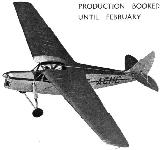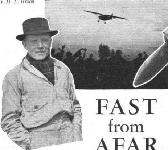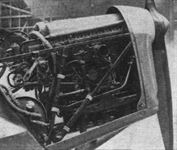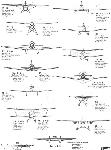
Описание
Страна : Великобритания
Год : 1933
Трехместный спортивно-туристический самолет
Варианты
- De Havilland - Puss Moth / D.H.80 - 1929 - Великобритания
- Cierva/De Havilland - C.24 - 1931 - Великобритания
- De Havilland - Leopard Moth / D.H.85 - 1933 - Великобритания
de Havilland DH.85 Leopard Moth
Самолет DH.85 Leopard Moth появился в 1933 году как наследник модели DH.83 Puss Moth. При внешнем сходстве с предшественником он обладал рядом отличий, в том числе новой конструкцией фюзеляжа. Силовой набор из стальных труб заменили деревянным из ели и фанеры с кабиной для пилота и двух пассажиров, сидевших плечом к плечу на заднем сиденье. Прототип впервые взлетел 27 мая 1933 года в Стэг-Лэйне. Всего через две недели он выиграл ежегодные авиагонки на Королевский кубок в Хэтфилде. Еще два таких же самолета заняли третье и шестое места. Это хорошее начало гарантировало коммерческий успех. За три года построили, сначала в Стэг-Лэйн, а затем в Хэтфилде, 132 таких аэроплана.
Вариант
DH.85A Leopard Moth: обозначение прототипа после переделки под установку мотора de Havilland Gipsy Six R мощностью 230 л.с. (172 кВт) с винтом изменяемого шага для испытаний
ТАКТИКО-ТЕХНИЧЕСКИЕ ХАРАКТЕРИСТИКИ
de Havilland DH.85 Leopard Moth
Тип: трехместный спортивно-туристический самолет
Силовая установка: рядный поршневой мотор de Havilland Gipsy Major мощностью 130 л.с. (97 кВт)
Летные характеристики: максимальная скорость 220 км/ч на оптимальной высоте; крейсерская скорость 192 км/ч на оптимальной высоте; начальная скороподъемность 168 м/мин; практический потолок 6555 м; дальность полета 1151 км
Масса: пустого самолета 637 кг; максимальная взлетная масса 1009 кг
Размеры: размах крыла 11,43 м; длина 7,47 м; высота 2,67 м; площадь крыла 19,14м2
Описание:
- de Havilland DH.85 Leopard Moth
- Flight, November 1933
DE HAVILLAND "LEOPARD MOTH" - Flight, April 1936
MODERN LIGHT AIRCRAFT REVIEWED
Фотографии
-
Мировая Авиация 47
Регистрационный номер: G-AIYS [8], SU-ABM [8], YI-ABI [8] Благодаря двигателю Gipsy Major мощностью 130л.с. (97 кВт) и обтекаемым формам, DH.85 (на рисунке) превосходил DH.80A по летным качествам. После установки мотора Gipsy R мощностью 230л.с. (172 кВт) самолет сменил обозначение на DH.85A. Он проходил испытания в ходе подготовки к созданию гоночного самолета DH.88 Comet.
-
Aeroplane Monthly 1983-06
Регистрационный номер: G-AIYS [8], SU-ABM [8], YI-ABI [8] This month marks the 50th birthday of D.H. Leopard Moth G-AIYS. Owned today by Victor Gauntlett, the Leopard is pictured near its Goodwood home in September 1980.
-
Aeroplane Monthly 1979-04
Регистрационный номер: G-AIYS [8], SU-ABM [8], YI-ABI [8] De Havilland Leopard Moth G-AIYS was photographed over Stauning, Denmark, by TORKILD BALSLEV in June 1975.
-
Aeroplane Monthly 2001-02 / E.Gandet - The Time Keepers /Swiss preservation/
Регистрационный номер: G-APKH, G-ACGS Originally registered as G-ACGS, D.H.85 Leopard Moth G-APKH was re-registered in 1963 and emigrated to Switzerland in 1991.
-
Aeroplane Monthly 1999-10 / T.Harmsworth - Over the Moon and under the 'Kosh /Oshkosh '99 report/
Регистрационный номер: G-ACOJ A small oasis of English shade is provided by Torquil Norman’s de Havilland Leopard Moth, which he flew across the Atlantic to attend the show. “It’s a sort of Millennium tribute to Geoffrey de Havilland,” he said, “and anyway I was getting a bit bored.”
-
Мировая Авиация 47
Регистрационный номер: HB-ABA [2], CH-416 [2] После Второй мировой войны самолеты Leopard Moth продолжали летать в Африке, Австралии, Индии, Англии и Швейцарии. На этом швейцарском самолете отчетливо видна стреловидная передняя кромка DH.85, придававшая крылу трапециевидную форму.
-
Aeroplane Monthly 1999-05 / M.Hooks - Personal album /Archive colour/
Регистрационный номер: HB-ALI [2], CH-290 [2] D.H. Leopard Moth HB-ALI went to Switzerland new as CH-290, taking up its HB- marks in June 1934. Seen at Biel/Bozingen - an airfield long since closed - on June 30, 1964, it was destroyed in a crash at Beromunster just over two months later.
-
Flight 1933-07 / Flight
FIRST PUBLIC APPEARANCE: The de Havilland "Leopard Moth" ("Gipsy Major"). This is one of the experimental machines. Those in the King's Cup Race will have the registration numbers G-ACHB, ACHC and ACHD. For the last machine it may be remembered that "DH" is flying "HD."
-
Aeroplane Monthly 1991-04 / J.Stroud - Wings of Peace
This view of the Leopard Moth shows the wing form and also the early form of aileron balance.
-
Flight 1933-08 / Flight
Регистрационный номер: G-ACHC [6] TAKING DELIVERY: Sir Derwent Hall Caine standing by the de Havilland "Leopard Moth" ("Gipsy Major") which has just been delivered to him. This is the machine entered by Sir Derwent in the King's Cup Race, and flown by Mr. Styran.
-
Flight 1933-11 / Flight Advertisements
Регистрационный номер: G-ACHC [6] -
Flight 1933-07 / Flight
Регистрационный номер: G-ACHC [6] THIRD HOME: Mr. A. J. Styran, flying Sir Derwent Hall-Caine's "Leopard Moth" ("Gipsy Major"), crossing the finishing line.
-
Flight 1933-07 / Flight
Регистрационный номер: G-ACHC [6] Mr. A. J. Styran flying Sir Derwent Hall-Caine's "Leopard Moth" ("Gipsy Major") in which he won the Heston-Cardiff race on Saturday, July 22.
-
Flight 1933-11 / Flight
Регистрационный номер: G-ACHC [6] AN EARLY "LEOPARD MOTH": The machine entered by Sir Derwent Hall Caine and flown by the late Mr Styran in the 1933 King's Cup Race.
-
Aeroplane Monthly 1988-08 / A.Henshaw - Miles for the Cup! (2)
Регистрационный номер: G-ACHC [6], G-ACUO Capt Wally Hope in Leopard Moth G-ACHC and J. Barbour and W. Gairdner in Leopard G-ACUO take off together. They were placed 15th and 18th respectively.
-
Flight 1933-11 / Flight
Регистрационный номер: G-ACHD [3] THE PROTOTYPE: The "Leopard Moth" which won the King's Cup Race this year, piloted by Capt. de Havilland himself. The production model does not differ in outward appearance from this machine.
-
Flight 1935-05 / Flight
Регистрационный номер: G-ACKL В модификацию de Havilland DH.85 Leopard Moth ввели изменения, схожие с изменениями версии DH.83 Puss Moth - новое трапециевидное складное крыло со стреловидностью передних кромок, а также смещенные верхние точки крепления амортизаторов основных стоек шасси.
-
Aeroplane Monthly 1994-02 / B.Elliott - Above, the law (1)
Регистрационный номер: G-ACKM The Leicester Aero Club used Leopard Moth G-ACKM The Leicester Fox III to give police officers air experience during its Air Safety Day at Braunstone on May 3, 1935.
-
Flight 1934-04 / Flight
Регистрационный номер: G-ACKP [7] RESERVED FOR THE AVIATOR: Cloud such as these are often to be seen even in mid-winter, but usually it is necessary, as in the case of this de Havilland "Leopard Moth," to go to a height of more than 9,000 ft. to get into the sunshine.
-
Flight 1936-05 / Flight
Регистрационный номер: G-ACKP [7] The De Havilland Leopard Moth (Gipsy Major);
-
Flight 1934-11 / Flight
Регистрационный номер: G-ACKP [7] -
Flight 1936-07 / Flight
Регистрационный номер: G-ACKP [7] -
Aeroplane Monthly 1991-04 / J.Stroud - Wings of Peace
Регистрационный номер: G-ACKP [7] Leopard Moth G-ACKP was owned by Capt Geoffrey de Havilland and fitted with spats.
-
Flight 1935-12 / Flight
Регистрационный номер: G-ACKP [7] A small fast monoplane. The D.H. Leopard Moth
-
Aviation Historian 7 / G.Skillen - In the shadow of the Tower
Регистрационный номер: G-ACLL [3] Leopard Moth G-ACLL is refuelled at Newtownards in June 1964. The elephant was going to be photographed in the Skyvan seen in the background to highlight the latter’s capacity - but Nellie had other ideas.
Другие самолёты на фотографии: Short SC.7 Skyvan - Великобритания - 1963
-
Aeroplane Monthly 1979-12
Регистрационный номер: G-ACLL [3] "Where would you like him, in the front or the back?"
-
Aeroplane Monthly 1979-07
Регистрационный номер: G-ACLL [3] Brian Skillicorn was the pilot of D.H.85 Leopard Moth G-ACLL, photographed near Old Warden on April 16, 1979 by Air Portraits
-
Flight 1936-06 / Flight
Регистрационный номер: G-ACLO Mr. A. Henshaw's winning Leopard Moth (Gipsy Major) arrives at Ronaldsway, having averaged 126.75 m.p.h.
-
Flight 1934-04 / Flight
Регистрационный номер: G-ACLY FOR FUEL AND OIL SERVICE: Mr. J . Taylor, a pilot and a member of the aviation staff of Shell-Mex & B.P., Ltd., standing beside one of the company's aeroplanes, a D.H. "Leopard Moth" ("Gipsy Major").
-
Air-Britain Archive 1981-02
Регистрационный номер: G-ACMA [3], BD148 [3] National Benzole's Leopard Moth G-ACMA survived impressment as BD148 and is still active, as shown during this visit to Sywell on 6.7.75.
-
Aeroplane Monthly 1988-10 / Personal album. Civil
Регистрационный номер: G-ACMA [3], BD148 [3] D.H.85 Leopard Moth G-ACMA snapped at Heston in 1934 when it was owned, by National Benzole. It is currently owned by S. J. Filhol and stored at Cork.
-
Aeroplane Monthly 1993-05 / Personal album. Civil
Регистрационный номер: G-ACMN [2] D.H. Leopard Moth G-ACMN at the time it was owned by Avis Ltd. It was sent to Coventry from Christchurch where it has been used as a hack by the de Havilland Aircraft Company. Today ’MN is owned by Henry Labouchere and was the subject of the June 1992 Preservation profile.
-
Aeroplane Monthly 1980-08 / News Spotlight
Регистрационный номер: G-ACMN [2] Another visitor was J. J. Parkes' D.H.85 Leopard Moth G-ACMN, based at Martlesham Heath. Note the strut-mounted generator.
-
Flight 1938-01 / Flight
Регистрационный номер: G-ACNN MAKING READY: Private-owner and other types inside the big service hangar at Heston. This hangar will, in due course, be taken over by British Airways and another service shop erected elsewhere.
-
Aeroplane Monthly 1994-02 / B.Elliott - Above, the law (1)
Регистрационный номер: G-ACRC [2] Leopard Moth G-ACRC was used as a spotter by the Lancashire police during a royal visit to the county in 1938.
-
Aeroplane Monthly 1986-06 / C.Read - Dunlop diversions (2)
Регистрационный номер: G-ACSF [3] D.H. Leopard Moth G-ACSF with Dunlop Anticer strips fitted to the wing, tailplane and fin leading edges.
-
Aeroplane Monthly 1986-06 / C.Read - Dunlop diversions (2)
Регистрационный номер: G-ACSF [3] Joe Wright, Dunlop Aviation’s general manager, points out the Anticer on Leopard Moth G-ACSF.
-
Aeroplane Monthly 1986-06 / C.Read - Dunlop diversions (2)
Регистрационный номер: G-ACSF [3] D.H. Leopard Moth G-ACSF with wings folded. Note the Anticer strip along the leading edge.
-
Flight 1937-10 / Flight
Регистрационный номер: G-ACSU Filling up: The refuelling and "re-oiling" pumps are all conveniently concentrated at the tarmac end of the new building. The oil, incidentally, is supplied under pressure through a number of filters.
-
Flight 1934-08 / Flight
Регистрационный номер: G-ACTG TO ASSIST SALES: The "Leopard Moth" recently acquired by Morris Motors Ltd.
-
Aeroplane Monthly 1988-10 / M.Oakey - Grapevine
Регистрационный номер: G-ACUS A new addition to the UK aah! de Havilland scene is Torquil Norman's Leopard Moth G-ACUS, which has been restored by Ben and Jan Cooper at Kintbury.
-
Flight 1936-09 / Flight
Регистрационный номер: G-ADWY Fig. 4 (top): The Leopard Moth in straight flight; the tufts indicate a stall just beginning at the wing roots. Fig. 5: A sideslip of 14 deg. immediately before the stall.
-
Aeroplane Monthly 1983-06 / De Havilland D.H.85 Leopard Moth G-AIYS /Preservation Profile/
Регистрационный номер: G-AIYS [8], SU-ABM [8], YI-ABI [8] In 1946 the aircraft returned to England and was registered G-AIYS
-
Air-Britain Archive 1986-03
Регистрационный номер: G-AIYS [8], SU-ABM [8], YI-ABI [8] Leopard Moth G-AIYS in pristine condition at sunny Sywell on 6.7.75. It was originally delivered to Egypt as SU-ABM and after a spell as YI-ABI was sold in the UK in 9.46, being prepared for British registration at Hanworth by West London Aero Services.
-
Aeroplane Monthly 1983-06 / De Havilland D.H.85 Leopard Moth G-AIYS /Preservation Profile/
Регистрационный номер: G-AIYS [8], SU-ABM [8], YI-ABI [8] -
Air Pictorial 1994-08 / G.Swanborough - British aircraft at war, 1939-1945 (8)
Регистрационный номер: BD148 [3], G-ACMA [3] Leopard Moth BD148, at Colerne in August 1945, was G-ACMA before impressment and was restored as such in 1946.
-
Aeroplane Monthly 1991-01 / Personal album. Civil
Регистрационный номер: HB-ABA [2], CH-416 [2] Originally registered CH-416 (the early system of Swiss registration), Leopard Moth HB-ABA was sold to Aviatik Basel in 1935. Later it was owned by Motor-fluggruppe Thun. This photograph was taken in 1963.
-
Aeroplane Monthly 1998-12 / M.Hooks - Weekend jolly /Inter-war civil/
Регистрационный номер: HB-ARI, HB-EFE Part of the visiting aircraft park at Heston. Visible are Hornet Moths EC-BBF and OE-DKS, BA Eagle HB-DES, Klemm KI 32 D-EREQ, Heinkel Kadett D-EQOS, Leopard Moths HB-ARI and HB-EFE, and Waco UIC PH-MAG.
Другие самолёты на фотографии: British Klemm BK-1 Eagle - Великобритания - 1934De Havilland Hornet Moth / D.H.87 - Великобритания - 1934Heinkel He-72 Kadett - Германия - 1933Klemm Kl.32 / Kl.36 - Германия - 1932WACO C / S Series - США - 1931
-
Aeroplane Monthly 1991-01 / Personal album. Civil
Регистрационный номер: HB-OTA, CH-366, G-ATFU Leopard Moth HB-OTA, originally CH-366, flew from Lausanne for many years. In 1965 it returned to the UK and was registered G-ATFU.
-
Aeroplane Monthly 1998-12 / M.Hooks - Weekend jolly /Inter-war civil/
Регистрационный номер: HB-OXO Other Thursday arrivals were M. Devaud and Lt-Col Gerber in Leopard Moth HB-OXO, accompanied by Col Messner and Capt Rieser in Puss Moth HB-EFE.
-
Aeroplane Monthly 1998-12 / M.Hooks - Weekend jolly /Inter-war civil/
Регистрационный номер: OO-APS [2] One of nine aircraft to put down at Lympne in bad weather, J.M. Provost’s Leopard Moth OO-APS arrived at Heston with the coupe SV-4 OO-ACB flown by Baron de Vinck de Winnezeele.
-
Air-Britain Archive 1980-02
Регистрационный номер: OO-APS [2] Leopard Moth OO-APS which remained on the register until 1951.
-
Aeroplane Monthly 1983-06 / De Havilland D.H.85 Leopard Moth G-AIYS /Preservation Profile/
Регистрационный номер: SU-ABM [8], G-AIYS [8], YI-ABI [8] G-AIYS was first delivered to Egypt and registered SU-ABM.
-
Aeroplane Monthly 1991-03 / M.Fife - The Great Air Race
Регистрационный номер: VH-UQO Keith Hatfield’s Leopard Moth doubled as Puss Moth VH-UQO, flown in the race by young Charles Melrose. Named My Hildegarde, after his mother, who sponsored Melrose’s flight, the Puss Moth was placed third in the Handicap Section having been the last aircraft flagged off from Mildenhall.
-
Aeroplane Monthly 1981-03 / News Spotlight
Регистрационный номер: VT-ADN An unidentified D.H. Puss Moth masquerading as D.H. Leopard Moth VT-ADN is now on exhibition at the new passenger terminal at Sahar (Bombay). It represents the Puss Moth VT-ADN in which J. R. D. Tata flew the first air mails over the Karachi-Bombay-Madras route on October 15, 1932.
-
Aeroplane Monthly 1991-04 / J.Stroud - Wings of Peace
Регистрационный номер: VT-AKH J. R. D. Tata in Air-India's Leopard Moth VT-AKH on the 30th anniversary of the inaugural Tata service from Karachi to Bombay and Madras.
-
Aeroplane Monthly 1983-06 / De Havilland D.H.85 Leopard Moth G-AIYS /Preservation Profile/
Регистрационный номер: YI-ABI [8], G-AIYS [8], SU-ABM [8] In 1945 it was sold to Iraq and registered YI-ABI
-
Flight 1933-07 / Flight
HIGH AND LOW: Mrs. Butler ("Leopard Moth") and F/O. Leech (Arrow "Active") taking the corner on the aerodrome at Hatfield in the middle of the final.
Другие самолёты на фотографии: Arrow Active - Великобритания - 1931
-
Flight 1933-07 / Flight
PALMAM QUI MERUIT FERAT: Capt. G. de Havilland is seen crossing the line to win the King's Cup Race in his latest production, the "Leopard Moth" ("Gipsy Major"). As a pioneer and the "old man" of the de Havilland Aircraft Co., Ltd., his popularity is great, and the enthusiasm with which his win was greeted was very sincere indeed. His staff are loyal and support him on all occasions.
-
Flight 1937-05 / Flight
Mr. H. F. Broadbent came from Australia in 6 1/2 Days by D.H. Leopard Moth
-
Flight 1935-03 / Flight
Mt. Blanc (15,780 ft.) towering above a sea of clouds - a photograph by DOUGLAS FAWCETT.
-
Flight 1933-07 / Flight Advertisements
WINNER OF THE KING'S CUP AIR RACE, 1933 CAPT. GEOFFREY DE HAVILLAND FLYING A D.H. LEOPARD MOTH DOPED WITH "TITANINE"
-
Flight 1934-10 / Flight
FOR A PORTUGUESE VENTURE: The De Havilland "Leopard Moth" on which Lt. Humberto da Cruz of the Portuguese Air Force intends to carry out a flight from Portugal to Timor, the farthest Portuguese possession. The machine was purchased by a national subscription, and Lt. Humberto da Cruz proposes to fly back from Timor via Hong Kong.
-
Flight 1935-11 / Flight
Регистрационный номер: HB-ALI [2], CH-290 [2] The Leopard Moth with his companion Mrs. Brodrick standing alongside
-
Flight 1933-10 / Flight
SOME BRITISH VISITORS AT BUC: Mr. Gordon Selfridge Jnr. and Miss Von Treschow and their "Leopard Moth."
-
Flight 1935-03 / Flight
The "Leopard Moth," on the aerodrome at Belp, with Mr. Fawcett's companion and Herr W. Eberschweiler.
-
Flight 1935-07 / Flight
Cooling themselves synthetically in the shade of a "Leopard Moth" are (left to right), Miss Fontes, sister of Luis Fontes of motoring fame, who was second in the Grosvenor Trophy Race, Mrs. Macdonald, Mrs. Battye, Mrs. Paterson, Mr. Roy Harben and Mr. Harold Perrin, Secretary of the Royal Aero Club, who appears to be blowing on his ice, presumably to raise its temperature before eating it.
-
Flight 1935-09 / Flight
De-spatted and unpropped - Sir Derwent Hall-Caine's Leopard Moth, flown by Capt. Hope, receives ministrations on Thursday.
-
Flight 1934-04 / Flight
A FLYING AMBASSADOR: His Excellency Sir Francis Humphrys, the British Ambassador at Baghdad, is a flying ambassador, for he owns and flies his own machine. The latter, a D.H. "Leopard Moth," was flown out to him from England recently, and here we see him starting up the engine prior to a 200-mile flight to Mosul, in Northern Iraq, with his son and daughter - who may be seen in the background on the right.
-
Flight 1934-09 / Flight
Aeroplane with the "Blanvac" silencer fitted in the exhaust system: a D.H. "Leopard Moth" (Gipsy Major).
-
Flight 1935-06 / Flight
In the main hall: Over the aisle is the D.H. "Leopard Moth" in which Lt. Humberto da Cruz and Sgt. Mech. Lobato flew from Lisbon to Portuguese Timor, and suspended from the roof is the Portuguese "Varela Sid" flying-boat glider.
Другие самолёты на фотографии: Varela Cid Portugal - Португалия - 1934
-
Air-Britain Archive 1982-03
To celebrate the centenary of the birth of Geoffrey de Havilland, the Moth Club arranged an aerial weekend tour for vintage DH types to such locations as Hatfield, Chester and Farnborough. It ended at White Waltham on 4.7.82 with the scene shown, forty-eight DH aircraft and various support craft all on the field together.
For the record, those visible were as follows: (all Tiger Moths unless stated) nearest row left to right: G-AOZB, G-APFU, G-ANTE, G-APMX, G-ANCS, G-AAWO DH.60G, G-AGYU, G-BEWN, G-EBLV DH.60, G-AOEG; second row G-AAZP DH.80A, G-AZCB SV.4C, N82AM, G-ASPV, G-AOAA, G-AEOA DH.80A, D-EEAJ, G-AYIT, G-ANFM and wingtips of G-ALIW; third row G-ANOH, G-AHBL DH.87B, G-ADGV, G-ANRN, G-ADND DH.87B, G-ANJA, G-ANDP, F-BGCS, G-ARAZ, G-AJOA, G-ANZU, G-ALWW; back row G-AELO DH.87B, G-AOEI, G-ACMN DH.85, G-AOZH, G-AIXD, G-AKIF DH.89A, T8191, G-AAMY DH.60G, G-ABEV DH.60G, HB-UBC, G-BFHH, PH-CSL and Proctor 4 G-ANXR. Present, but not visible in this shot were Tiger Moths G-ANFW, G-BACK; Jackaroo G-AOIR; DH.85 G-AIYS; DH.90 G-AEDU and various supporters including Great Lakes D-EBGL and Proctor G-AOGE.
Anyone requesting the registrations of the three Cherokees and the Sipa will have their subscriptions cancelled immediately!Другие самолёты на фотографии: De Havilland Dragon Rapide / Dominie / D.H.89 - Великобритания - 1934De Havilland Gipsy Moth / Moth X - Великобритания - 1928De Havilland Hornet Moth / D.H.87 - Великобритания - 1934De Havilland Puss Moth / D.H.80 - Великобритания - 1929De Havilland Tiger Moth / D.H.82 - Великобритания - 1931Percival Proctor / P.28 - Великобритания - 1939Stampe et Vertongen SV-4 - Бельгия - 1933
-
Flight 1936-12 / Flight
APPOSITE: Christmas greetings from Air Service Training Ltd. at Hamble. The message is formed by white-overalled humanity "on the hands down," and the "A.S.T." consists of the ten different aircraft types which form the organisation's fleet: Avro V, 626, Avian, Tutors and Cadets; two-seater Siskin; A.W. Atlas; two Cutty Sarks; and D.H. Leopard Moth and Hornet Moth.
Другие самолёты на фотографии: Armstrong Whitworth Atlas / Ajax - Великобритания - 1925Armstrong Whitworth Siskin - Великобритания - 1921Avro Avian / Type 594/616 - Великобритания - 1926Avro Cadet / Type 631/643 - Великобритания - 1932Avro Five / Type 619 / Six / Type 624 - Великобритания - 1929Avro Tutor/Sea Tutor/Prefect / Type 621/646/626 - Великобритания - 1929De Havilland Hornet Moth / D.H.87 - Великобритания - 1934Saunders-Roe Cutty Sark / A.17 - Великобритания - 1929
-
Aeroplane Monthly 1986-06 / C.Read - Dunlop diversions (2)
Anticer stripping on a Leopard Moth’s tailplane at Schiphol Airport, Holland in 1935.
-
Flight 1933-11 / Flight
The tail wheel has a solid rubber tyre, and is free to rotate through 360 deg. Springing is by rubber in compression.
-
Flight 1938-03 / Flight
The De Havilland Gipsy Major I, here seen in a Leopard Moth, runs for 1,000 hours between overhauls.
-
Flight 1933-11 / Flight
SECURING THE WING FOLDING: A spring-loaded plunger passes through the forked end on the spar and through the eyebolt on the fuselage. When the plunger is sent home it is locked by turning the tap which engages with the notch on the plunger shown in the left-hand photograph.
-
Flight 1933-11 / Flight
NEAT: The dashboard of a "Leopard Moth" ("Gipsy Major") belonging to Mr. Hunt, of South Africa. Besides the usual range of Smith's Instruments and the Husun Compass, there is an air log, at the top on the left-hand side, a Reid & Sigrist Turn and Bank Indicator in the centre, with a Pitch Indicator alongside it, which is showing a steep angle of climb, and a Smith's clock on its right.
-
Flight 1933-11 / Flight
THE CABIN OF THE "LEOPARD MOTH": Comfortable seating is provided for two passengers side by side. The rear set of controls is removable.
-
Flight 1933-07 / Flight
A FINE FLIGHT: Mrs. Butler, wife of the Chairman of the de Havilland Aircraft Co., Ltd., piloted a "Leopard Moth" ("Gipsy Major") with great skill throughout the Race. Mr. Butler was her navigator.
-
Aeroplane Monthly 1994-02 / B.Elliott - Above, the law (1)
Регистрационный номер: G-ACRC [2] Inspector Tommy Platt is pictured in the back seat of G-ACRC.
-
Flight 1938-07 / Flight
Регистрационный номер: G-ACHD [3] Mr. S. R. Crow’s flying scale-model Leopard Moth.
-
Flight 1933-08 / Flight Advertisements
Регистрационный номер: G-ACHD [3] -
Flight 1936-07 / Flight
Регистрационный номер: G-AHAH Mr. Henery's 1 1/2 in. to 1 ft. Leopard; even the instruments are to scale
-
Flight 1934-07 / Flight
DESIGN AIDS TO SPEED (3) A small curved guard on a D.H. "Leopard Moth," where the exhaust pipe was short, which served to keep the the fumes from coming up to the cockpit windows.
-
Flight 1934-07 / Flight
DESIGN AIDS TO SPEED (6) The "Leopard Moth" also has the aileron balance under the wing but exposed to the air stream.
-
Flight 1934-10 / Flight
Другие самолёты на фотографии: Bellanca 28 Flash - США - 1934De Havilland Comet / D.H.88 - Великобритания - 1934De Havilland Fox Moth / D.H.83 - Великобритания - 1932Fairey Fox - Великобритания - 1925Harkness & Hillier All Australian - Австралия - 1934Lockheed Sirius / Altair 8 - США - 1929Lockheed Vega - США - 1927Miles Falcon M.3 / Hawcon M.6 - Великобритания - 1934Monocoupe 90 / 110 / 145 - США - 1930Northrop Delta - США - 1933Percival Gull - Великобритания - 1932Short Scion / S.16 - Великобритания - 1933
-
Flight 1933-11 / Flight
D.H.85 "Leopard Moth" D.H.Gipsy Major Engine
- Фотографии




























































































